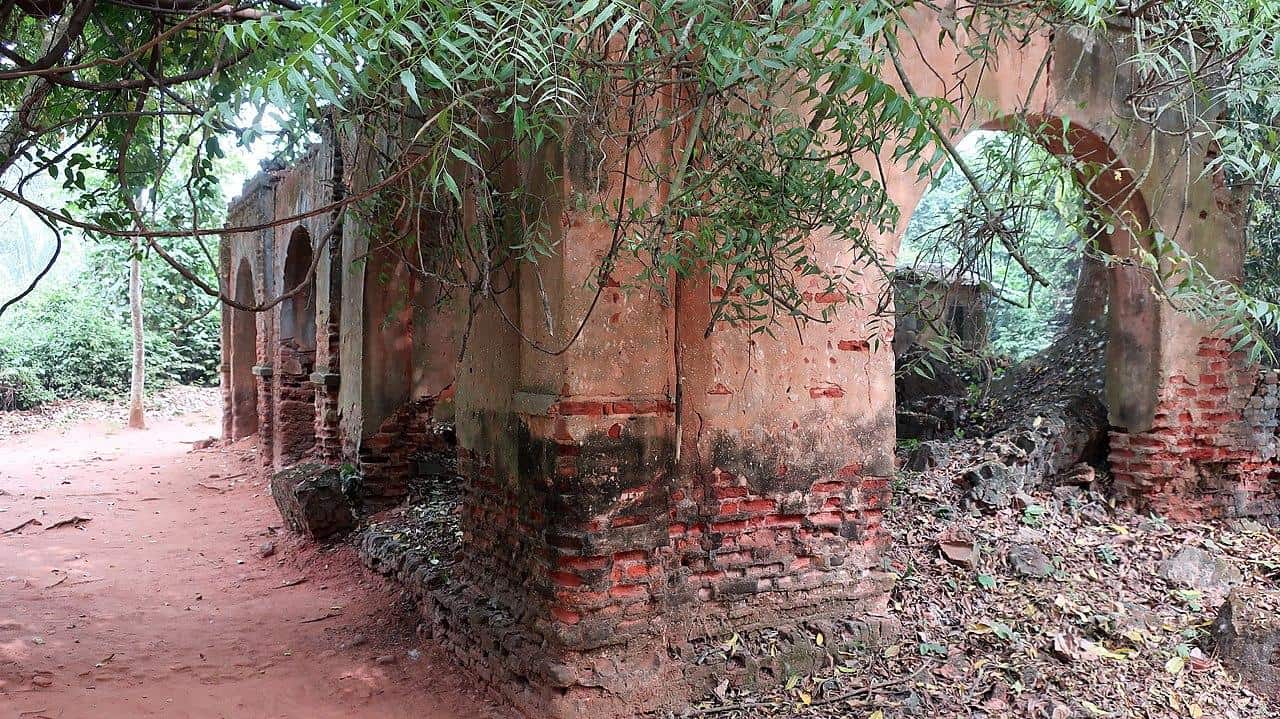
Once the epicenter of the Atlantic slave trade, the coastal Beninese city of Ouidah served as the main port of several African kingdoms that formerly dominated the area. Often dubbed as the world's Voodoo capital, the city is chockfull of religiously significant places and spectacular monuments. Standing out among the city's numerous worthy sites to explore is Ouidah's Sacred Forest, a pristine patch of holy woodland that offers an authentic glimpse into the local traditions and religious beliefs.
Nestled in the eastern outskirts of Ouidah, the city’s sacred forest serves as a major pilgrimage site for Vodun adherents who frequent the wooded garden for their ritual practices, divine inspiration and even initiation ceremonies for the younger members of the community.

The entrance gate to the forest
photography by: Kulttuurinavigaattori/ Wikimedia Commons
Officially named the Sacred Forest of Kpassè or Kpassè Zoun, the semi-wild woodland is dedicated to King Kpassè, the 16th century ruler of the African kingdom of Whydah that once encompassed the area of modern-day Ouidah.
Legend has it that in the midst of a brutal conflict with a neighboring kingdom, the king fled for his life after hundreds of ferocious warriors were ordered to capture and kill him. With no other choice, Kpassè ran into a close-by forest, where he turned himself into an Iroko tree, known scientifically as Milicia excelsa.

The derelict building that houses the sacred tree where allegedly the spirit of Kpassè resides
photography by: Erik Kleves Kristensen/ Wikimedia Commons
Towering above the ruins of an old-building, the legendary tree which allegedly holds the spirit of the famed monarch now serves as the centerpiece of the forest, and to large extent is the reason behind its sacred status. Voodoo worshipers and locals who visit the forest, strongly believe that if you touch the tree and make a wish, it will definitely come true.

The sacred Iroko tree which according to the legend hosts the spirit of King Kpassè
photography by: Erik Kleves Kristensen/ Wikimedia Commons
It has been told that during his hunt, the Dahomean ruler’s troops who were looking for Kpassè, suddenly faced with unexpected challenge, when massive swarms of pythons attacked them and ultimately halted their offence as they made their way into the sacred forest where the fugitive king was hiding.
As a gesture for their protective role, several monuments where the formidable serpents are worshiped and revered were erected all over Ouidah, including a concrete hut for rituals with snakey murals in the forest itself, and the city’s Temple of Pythons, where dozens of live pythons are kept.

A round concrete hovel where rituals honoring the famed pythons occasionally take place
photography by: Rachad sanoussi/ Wikimedia Commons
The holy jungle originally covered more than 30 hectares of pristine woodland, however, as the surrounding town encroached on the forest, it shrunk in size to a meager 4 hectares. Fortunately, the Beninese government recently passed a legislation that protects the historically significant site, along with the country’s other 3,000 sacred forests.

The entrance building that leads to the forest's convent, where initiation ceremonies are being held
photography by: Kulttuurinavigaattori/ Wikimedia Commons
Following the country’s largest Voodoo festival in 1991 at the site, dozens of sculptures of Voodoo deities were created and placed all across the forest, and so, the wooded area was turned into a sort of an open-air museum for contemporary local art.

On the left: the iconic Ouroboros sculpture. On the right: one of Hêbiosso's sculptures in the premises
photography by: Kulttuurinavigaattori/ Wikimedia Commons
Among the many sculptures visitors can behold at the premises are Gu, the god of war and blacksmiths, Sakpata, the divinity of illness and smallpox, and perhaps most notably, the somewhat sexually explicit statue of Lègba, the messenger of all Voodoo gods who also according to Haitian worshipers, promotes harmony and dialogue between people, and as such, is usually the protagonist of opening ceremonies.

On the left: Sakpata, the divinity of smallpox. On the right: the phallic sculpture of Lègba
photography by: Rachad sanoussi/ Wikimedia Commons
Surrounded by tall vegetation and armed with lightning bolts is Hêbiosso (aka Hêvièsso), the god of thunders and storms, who often unleashes his superpowers to triggers lightnings that inflicts death on future villains who are about to commit horrific crimes such as murder or rape.
While being only a far cry from the extensive rainforest it used to be prior to human encroachment, this vestige of endemic nature still boasts an entire eco-system, with squirrels, pythons, vipers and a host of forest-dwelling birds being some of its permanent tenants.
Nevertheless, it is the flora which makes this sacred woodland particularly interesting. Among the forest’s 36 species of plants and fungi, are some with medicinal properties like a tree secreting a cheese-shaped sap or the Newbouldia laevis, known also as the boundary tree, whose powdered leaves are used to treat many kinds of illnesses as well as a ceremonial ingredient in Vodun rituals.

On the left: some of the forest's medicinal leaves. On the right: a cheese-like sap secretion
photography by: Rachad sanoussi/ Wikimedia Commons